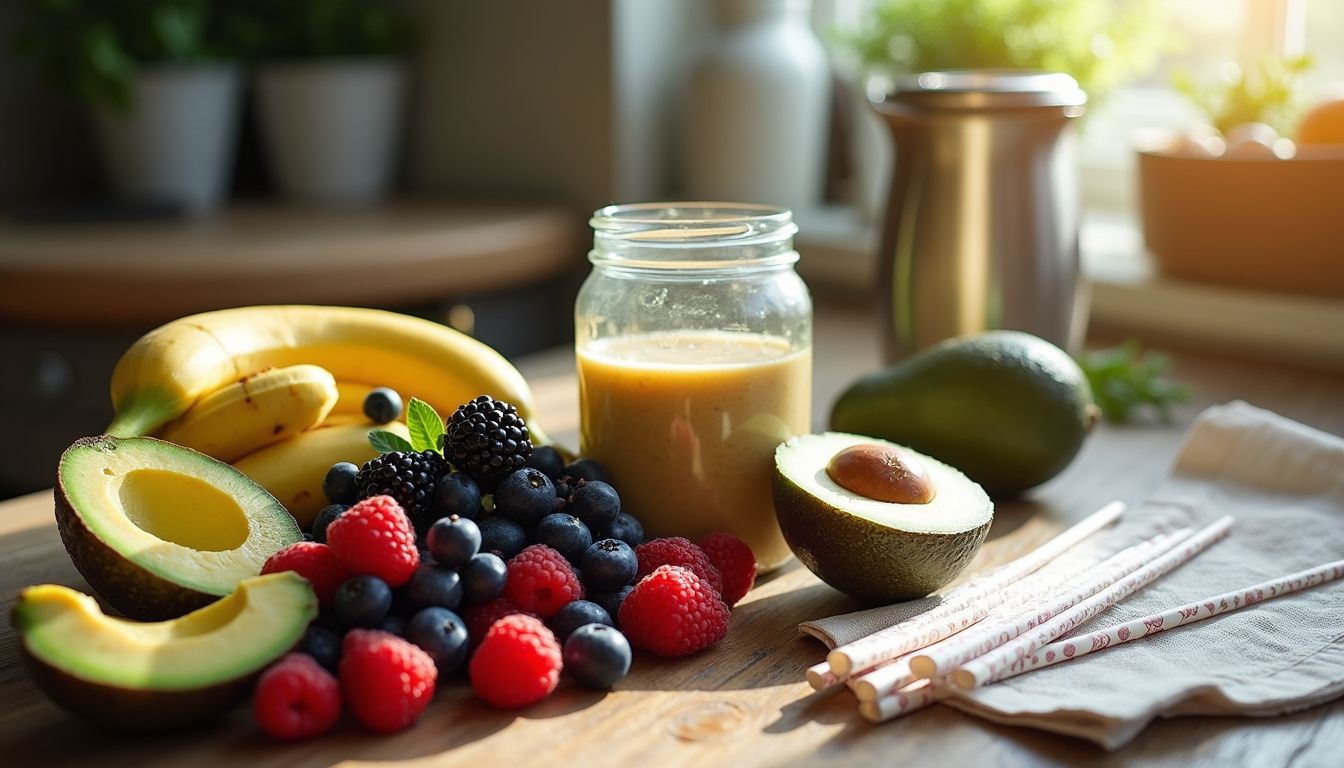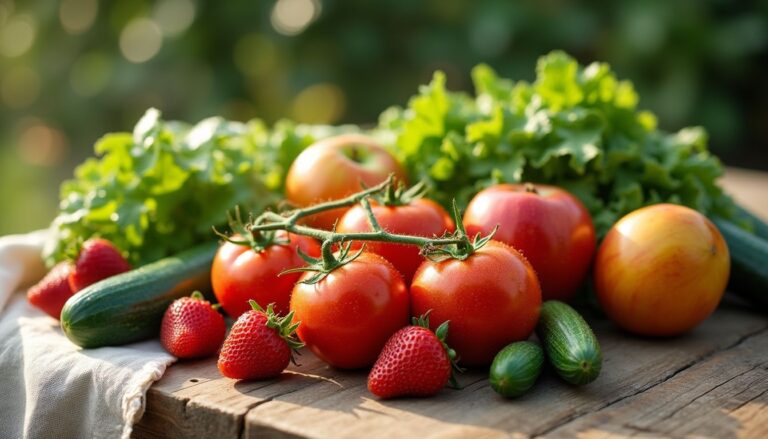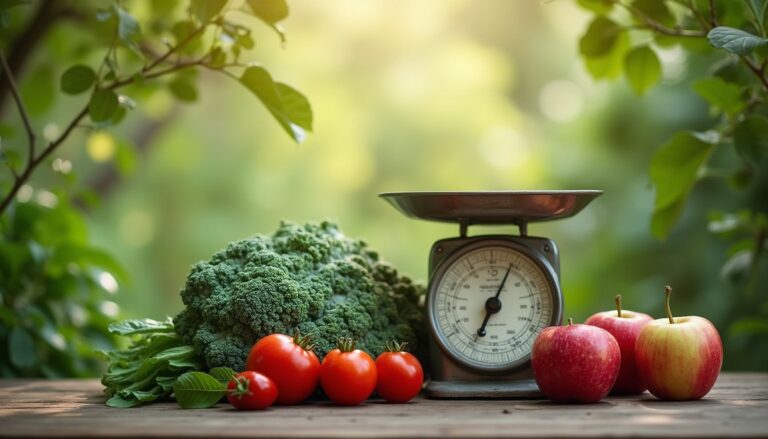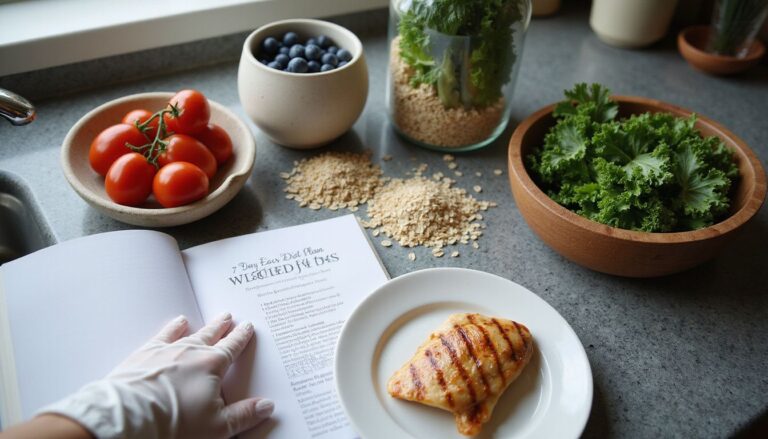Delicious High Calorie Smoothies For Weight Gain And Nutrition
Our Nutrition Assistant AI Suite will transform your body. You will lose fat, get toned, and build muscle. Gain confidence and optimal health.
If you struggle to gain weight or meet your nutrition goals, you are not alone. Many people find it hard to eat enough every day. High-calorie smoothies make it easier by packing calories, protein, and vitamins into one easy drink.
This guide explains the benefits, shares proven recipes, and offers simple tips to boost your calorie intake in a healthy way. You will see how basic ingredients can help you reach your weight goals without stress.
Key Takeaways
- High-calorie smoothies can provide 400 to 1,100 calories per serving with balanced macros for steady weight gain.
- Key ingredients like Greek yogurt, nut butters, and whole milk significantly raise protein and total calories.
- Recipes such as Chocolate Avocado Smoothie with Flaxseed offer up to 671 calories and 36 grams of protein to support muscle repair.
- Natural sweeteners like honey, maple syrup, and dates add energy without refined sugar; chia and flaxseeds add fiber and omega-3 fats.
- Frozen fruit preserves most vitamins for months; leafy greens increase vitamin K and other micronutrients.
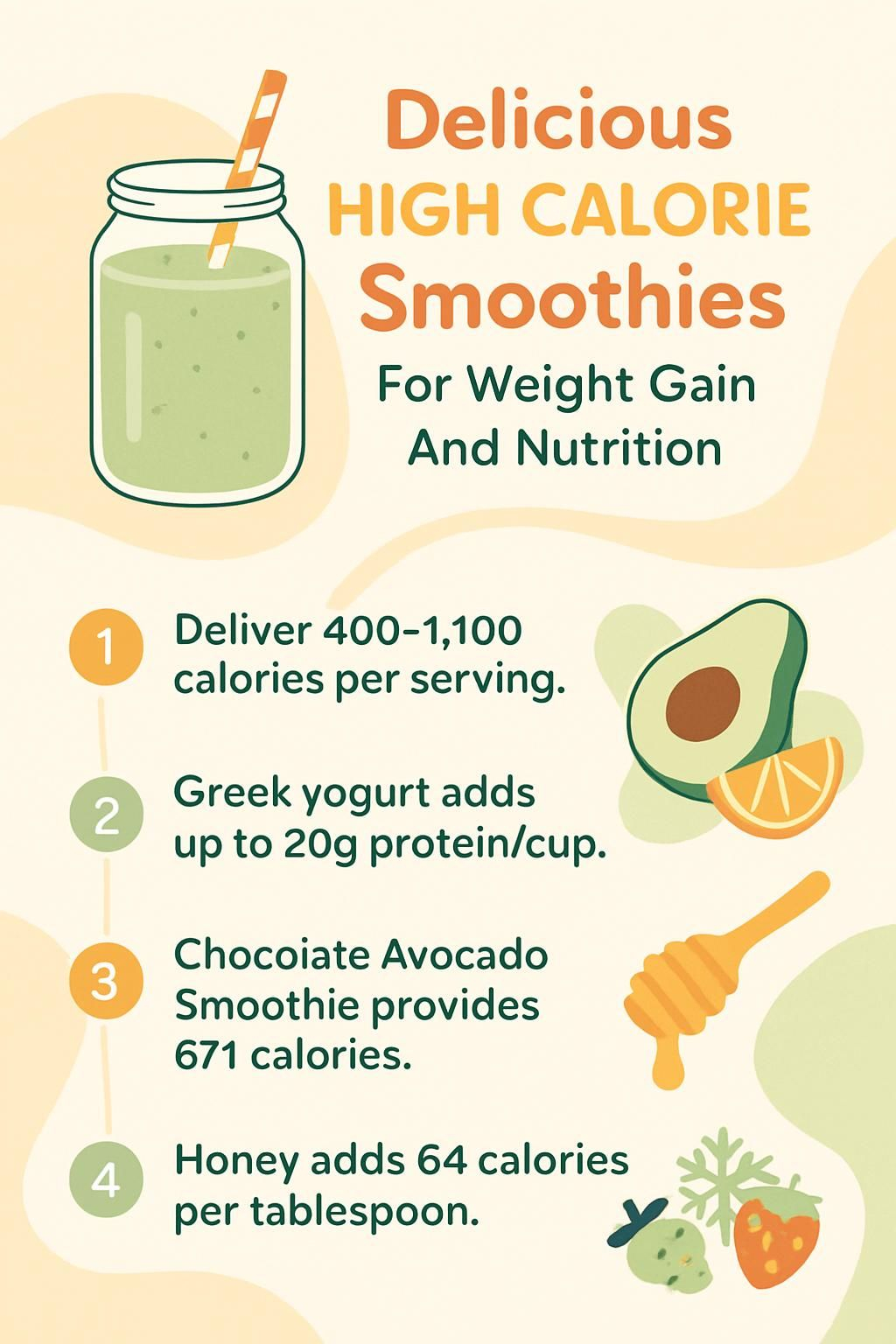
Why Should I Choose High-Calorie Smoothies for Weight Gain?
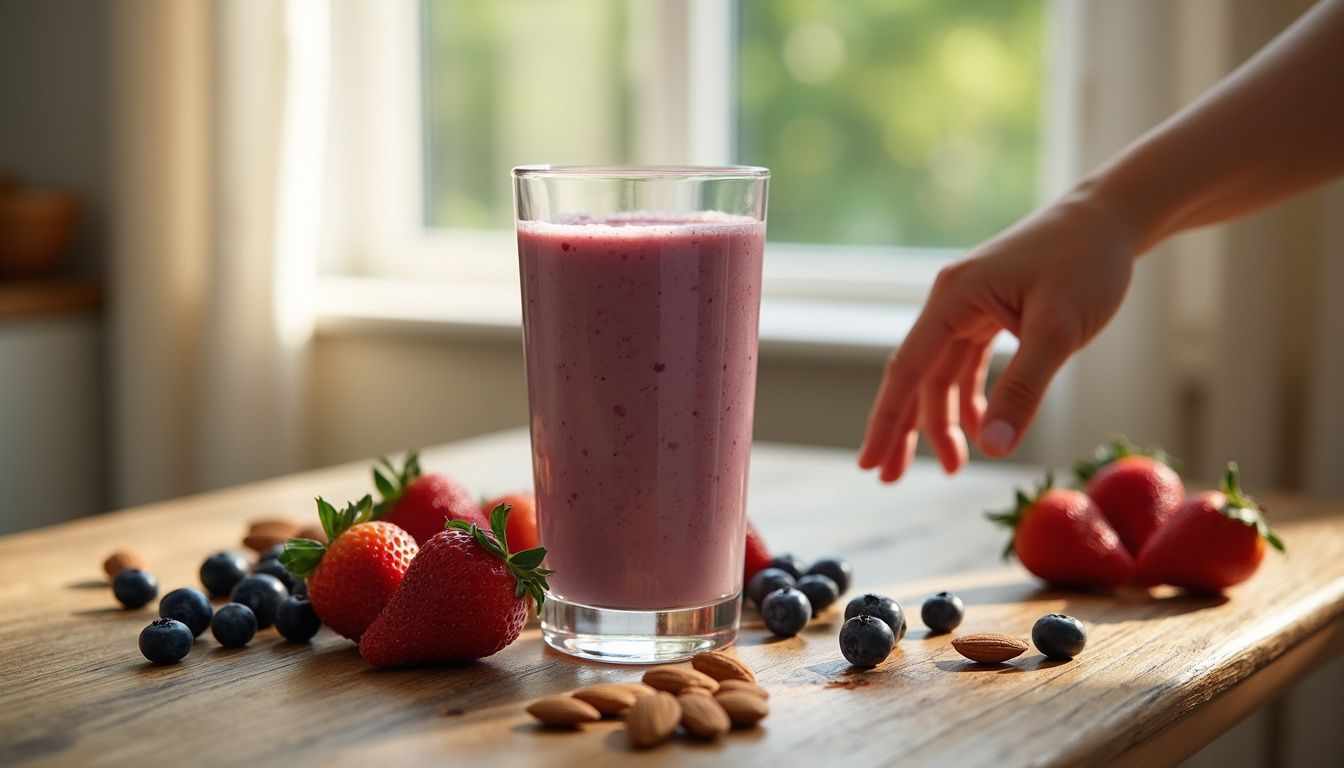
High-calorie smoothies help you meet daily calorie needs for healthy weight gain. You get a drink that tastes great and also fuels your body with key nutrients.
How are high-calorie smoothies convenient and customizable?
You can blend a calorie-rich smoothie in five minutes using a blender and basic ingredients. Start with whole milk or almond milk for extra calories. Add protein with Greek yogurt, silken tofu, or a scoop of protein powder.
Mix in banana, oats, or honey for energy-dense carbs. Stir in peanut butter for healthy fats. Use more liquid for a thinner drink, or choose frozen fruit for a creamier texture.
Swap flavors easily. Try berries, mango, cocoa powder, or even coffee. Smoothies work well as meals or snacks because they are quick to make and easy to carry.
I often blend two servings at once. One goes in my bottle, and the other goes in the freezer for a fast meal later.
Smoothies are fast and flexible, just blend what you have and sip your way to steady weight gain.
What essential nutrients do high-calorie smoothies provide?
High-calorie shakes and smoothies give you protein, carbohydrates, and healthy fats in one glass. Protein comes from Greek yogurt, milk, protein powder, or silken tofu. Carbs come from oats, fruit, and honey or dates. Healthy fats come from avocado, nut butters, or coconut oil.
Fat has 9 calories per gram. Protein and carbs have 4 calories per gram. Many blends also deliver vitamins A, C, and E from fruit and greens, plus minerals like potassium from bananas and magnesium from seeds.
Ground flaxseed adds omega-3 fats, which support heart health. Dairy ingredients boost calcium, and tofu adds iron. Smoothies are a simple way to raise your intake when big meals feel tough during recovery or busy periods.
Why are high-calorie smoothies easy to digest and absorb?
Blending breaks down tough fibers, which helps your body absorb nutrients faster. Liquid meals usually leave the stomach quicker than solid foods, so you can eat more without feeling stuffed.
People with low appetite or certain health conditions often find smoothies gentler on digestion. Drinks made with Greek yogurt or protein powder can raise your calorie intake without heavy fullness. Dietitians often suggest a homemade smoothie instead of a large solid meal for easier absorption.
Key Ingredients for High-Calorie Smoothies
Simple swaps can raise calories and improve nutrition. Use the ideas below to build a richer base for weight gain.
Healthy fats: nut butters, avocado, and coconut oil
Healthy fats raise calories fast and help your body absorb fat-soluble vitamins. They also make smoothies creamy and satisfying.
- Nut butters like almond, peanut, or cashew add about 100 calories per tablespoon and blend smoothly.
- Half an avocado adds about 160 calories plus monounsaturated fats and potassium for heart health.
- Coconut oil adds medium-chain triglycerides, or MCTs. One tablespoon provides roughly 120 calories and blends well when melted first.
- Flaxseed supplies omega-3 fats and fiber. One tablespoon adds about 55 calories and supports heart health.
- Full-fat Greek yogurt delivers protein, calcium, and fat. A cup often contains around 220 calories depending on the brand.
- Almonds, cashews, or walnuts add calories and micronutrients like magnesium and vitamin E when blended.
- Using these fats helped me hit daily calorie goals during sports training without relying on refined oils.
These options make your smoothie more filling while delivering key nutrients for healthy weight gain.
Protein sources: Greek yogurt, protein powders, and silken tofu
Protein supports muscle repair and keeps you full. You can mix animal or plant sources to fit your diet.
- Greek yogurt offers up to 20 grams of protein per cup and adds a creamy texture plus calcium for bones.
- Protein powders, such as whey, casein, pea, or soy, usually provide 15 to 25 grams per scoop.
- Silken tofu has about 8 grams per half-cup, blends smoothly, and is a good dairy-free option.
- Pasteurized liquid egg whites add high-quality protein with little fat and are easy to measure.
- Whole milk and kefir add about 8 grams of complete protein per cup. Kefir also includes probiotics for gut health.
- Combining sources like Greek yogurt and whey may improve recovery after workouts, based on sports nutrition research.
- Pairing protein with nut butters or seeds increases total nutrient density for steady progress.
These protein sources make it simple to meet daily needs and build muscle while you gain weight.
Calorie-dense bases: whole milk, almond milk, and fruit juice
Choosing a richer base raises calories without adding much volume. These liquids blend smoothly and improve flavor.
- Whole milk gives about 150 calories per cup with protein, vitamin D, and calcium for bones.
- Almond milk works for dairy-free needs. Unsweetened versions have about 40 calories, while sweetened varieties range from 60 to 80 calories per cup.
- Fruit juice adds flavor and calories. Orange juice has around 110 calories per cup and supplies vitamin C and potassium.
- Commercial protein drinks can add 10 grams of protein or more and up to 200 calories per serving.
- Heavy cream raises calories quickly. Two ounces add over 200 calories, useful for higher-calorie plans.
- Whole milk kefir has about 150 calories per cup and provides probiotics to support digestion.
Pick a base that fits your taste and calorie target, then build from there.
Natural sweeteners: honey, maple syrup, and dates
Natural sweeteners boost calories and taste without refined sugar. They also add small amounts of minerals and antioxidants.
- Honey adds about 64 calories per tablespoon and blends well with fruit or cocoa.
- Maple syrup provides about 52 calories per tablespoon and a smooth, warm flavor.
- One Medjool date supplies about 66 calories plus fiber, potassium, and magnesium.
- These options raise energy while keeping your ingredient list simple and familiar.
- Dates add a caramel-like note and pair nicely with banana or chocolate.
- Mix and match to find your favorite flavor balance.
- Start light, then add more to taste so you keep sugars reasonable.
What Are the Benefits of High-Calorie Smoothies?
High-calorie smoothies deliver convenient calories and a steady balance of macros. A good blend can support your goals without heavy meals.
How do smoothies support healthy weight gain?
To gain weight, you need a calorie surplus, which means eating more than you burn. Smoothies concentrate calories in a small volume, so you can drink more energy without discomfort.
For example, an 1,100 calorie blend might include frozen strawberries, peanut butter, a banana, honey, oats, whey protein, and whole milk. You can finish it faster than a large plate of food.
Peanut butter and whole milk add healthy fats. Whey protein supports muscle growth, and oats provide long-lasting carbs. You avoid empty calories from sodas and get vitamins and minerals with each sip.
What balanced nutrition do these smoothies offer?
Each high-calorie smoothie can deliver a balanced mix of protein, carbs, and fats. The Chocolate Peanut Butter Shake with Greek Yogurt, for instance, offers about 30 grams of protein, 23 grams of fat, and 65 grams of carbs per serving.
You also get micronutrients. Spinach and berries add vitamins and antioxidants. Bananas supply potassium, and dairy ingredients provide calcium. I noticed steadier energy after a blueberry tofu smoothie at breakfast because it offered protein and antioxidants together.
How can high-calorie smoothies boost energy levels?
Fats provide 9 calories per gram, and carbs provide 4 calories per gram. This mix gives both quick and long-lasting energy, which can reduce fatigue.
The Apple Cinnamon Hemp Heart Protein Smoothie reaches about 895 calories per serving. That calorie level can help on busy days when you need extra fuel.
Fruits offer fast energy. Nut butters and avocado provide steady energy. A calorie-dense blend before work can help you stay focused through long shifts.
Why do smoothies enhance muscle recovery and growth?
Protein is vital for rebuilding muscle after exercise. A Chocolate Avocado Smoothie with Flaxseed delivers about 36 grams of protein per serving. A casein-based bedtime smoothie can provide around 44 grams.
Greek yogurt, egg whites, and whey supply complete amino acids, which are the building blocks of muscle. When you combine protein with healthy fats and carbs plus vitamins from fruit and greens, your body has what it needs to recover and grow stronger.
What Are Some Delicious High-Calorie Smoothie Recipes?
Use these recipes to raise calories and keep nutrition balanced. Adjust liquids to change thickness, then sweeten to taste.
Chocolate Peanut Butter Shake with Greek Yogurt
Blend one large banana, 3/4 cup whole milk, 3 tablespoons unsweetened cocoa, 3/4 cup full-fat Greek yogurt, 1 tablespoon honey, and 1 tablespoon peanut butter.
This smoothie has roughly 587 calories with about 30 grams of protein, 23 grams of fat, and 65 grams of carbs. Whole milk and peanut butter add creaminess and healthy fats. I like this one after workouts because it helps me recover without a heavy meal.
Triple Berry Smoothie with Egg Whites
Want something bright and fruity? A Triple Berry Smoothie with Egg Whites provides about 491 calories per serving.
Use 3/4 cup pasteurized egg whites for 26 grams of lean protein. Blend strawberries, blueberries, raspberries, a small avocado, and half a cup of orange juice. You get fiber, antioxidants, and about 45 grams of carbs. Pasteurized egg whites are safe to drink and support muscle building.
Green Smoothie with Avocado and Spinach
Blend 3 cups spinach, 1 cup full-fat plain Greek yogurt, 6 ounces fruit juice, and half an avocado. This mix offers about 495 calories with 28 grams of protein, 11 grams of fat, and 71 grams of carbs.
Spinach adds vitamins A and K. Avocado brings healthy fats for lasting energy. Add chia seeds or honey if you want extra calories or sweetness.
Coffee Protein Smoothie with Whey Protein
Start your day with coffee plus protein. Blend 2/3 cup cold brewed coffee, 6 to 8 ice cubes, one frozen banana, 1 tablespoon cocoa powder, 1 tablespoon almond butter, 1/4 cup chocolate or mocha whey protein, and 2 tablespoons chia seeds.
This blend provides roughly 385 calories. You get about 14.5 grams of protein and 18.1 grams of fat for steady energy. Use whole milk instead of water if you want more calories and a creamier texture.
Apple Cinnamon Smoothie with Hemp Hearts
If you want a cozy flavor, try this spiced blend. Combine 1.5 cups whole milk, two small cored apples, 1/3 cup rolled oats, 2 tablespoons almond butter, 2 tablespoons hemp hearts, and 2 tablespoons chia seeds. Add one Medjool date, 1 teaspoon vanilla, a shake of cinnamon, and ice.
Each serving reaches about 895 calories with 32 grams of protein, 47 grams of fat, and 86 grams of carbs. Hemp hearts provide plant-based omega-3 fats and protein. Oats add fiber and make the drink filling.
Sources:
1. House JD et al., “Hempseed as a Nutritional Resource: An Overview,” Euphytica (2010).
2. USDA FoodData Central (2024).
Strawberry Banana Smoothie with Kefir
Blend 1 cup strawberries, 1 ripe medium banana, and 1 cup whole milk kefir. Add 1/4 cup oats for more calories and fiber. Toss in ice for a colder drink.
This recipe provides about 403 calories and 14 grams of protein. Kefir supplies probiotics for gut health and a tangy taste. It is a great post-workout option when you want something light but filling.
Explore other calorie-dense blends such as Chocolate Avocado Smoothie with Flaxseed next.
Chocolate Avocado Smoothie with Flaxseed
Blend 1 cup whole milk, half a ripe avocado, four to six pitted dates, 2.5 tablespoons cocoa powder, ice, 1 teaspoon vanilla, one medium banana, 1/4 cup chocolate whey protein, and 1 tablespoon ground flaxseed.
One serving provides about 671 calories and 36 grams of protein. You also get 27 grams of fat from avocado and flaxseed, including omega-3 fats for heart health. Dates add natural sweetness, and banana supports potassium intake.
| Calories | Protein | Fat | Carbohydrates |
|---|---|---|---|
| 671 | 36 g | 27 g | 71 g |
A friend shared that adding avocado helped them enjoy more greens because the cocoa flavor stands out while the nutrition stays strong.
Blueberry Smoothie with Silken Tofu
Blend 1 cup silken tofu, 1 cup unsweetened soy milk, 1 medium banana, and 1 cup blueberries. Add 2 to 3 ice cubes and 1 tablespoon honey if you like more sweetness.
This recipe offers about 493 calories with 28 grams of protein, 13 grams of fat, and 66 grams of carbs. Silken tofu creates a smooth texture without dairy, and blueberries add antioxidants. It is a solid post-workout or breakfast choice.
Pumpkin Pie Shake with Egg White Protein
Blend 1 cup whole milk, 1 medium frozen banana, 3 tablespoons pumpkin puree, and 1 scoop vanilla egg white protein. Add 1 tablespoon almond butter, 1/8 teaspoon pumpkin pie spice, and 1/8 teaspoon cinnamon. Ice thickens the drink. Top with 1 tablespoon graham cracker crumbs if you like a little crunch.
This shake has about 535 calories, 36 grams of protein, 19 grams of fat, and 55 grams of carbs. It supports recovery after workouts and fits well into a weight gain plan.
How Can I Make the Perfect High-Calorie Smoothie?
Build each smoothie around a protein, a healthy fat, and a carbohydrate. Then fine-tune sweetness and texture to your taste.
How do I balance proteins, fats, and carbs?
Pick one protein, one fat, and one carb source for each blend. Use whey, casein, or pea protein powder, or add Greek yogurt to reach your protein target.
Add fats with almond butter, peanut butter, avocado, or coconut oil. Choose carbs from oats, fruit, dates, or honey. Blend with whole milk or almond milk.
A typical Super Smoothie may have 444 calories with 34 grams of protein, 48 grams of carbs including fiber, and 18 grams of fat. This mix kept my energy steady after soccer practice in college and did not leave me sluggish.
Adjust amounts to hit your goals and the thickness you like.
Why use frozen fruits for creamier texture?
Frozen fruit makes smoothies thick and creamy without watering down flavor. Tiny ice crystals blend into a smooth texture, which beats using plain ice.
Freezing preserves most vitamins for months, based on food science data. For example, frozen strawberries keep much of their vitamin C. Use one cup of frozen fruit with milk for a rich base. Frozen bananas also act like a natural thickener.
How do I adjust sweetness and consistency to taste?
Sweeten with honey, maple syrup, or pitted dates. Start with one teaspoon, blend, then taste. Ripe bananas and mangoes also raise sweetness while adding nutrients.
For a thinner smoothie, add liquid two tablespoons at a time. For thicker texture, add frozen fruit or a few ice cubes. Blend longer for a smoother drink. Always taste before pouring so you can tweak both flavor and thickness.
Creative Variations and Add-Ins
Keep smoothies interesting with nutrient boosters and flavor twists. Small changes can add a lot of value.
How do greens like kale or spinach add nutrients?
Spinach and kale raise your micronutrient intake with few calories. Spinach adds iron, vitamin K, magnesium, folate, and fiber without a strong flavor. Kale brings vitamin A, vitamin C, calcium, and antioxidants.
Adding about 3 cups of fresh spinach boosts nutrition without turning your smoothie bitter. Leafy greens also raise fiber, which can steady energy and support digestion.
Reference: U.S. Department of Agriculture, National Nutrient Database.
…
What benefits do chia or flaxseeds provide?
Chia and flaxseeds add healthy fats, fiber, and calories. Two tablespoons of chia provide around 140 calories and nearly 10 grams of fiber. Flaxseed adds omega-3 fats and lignans that support heart health.
I often blend two tablespoons of chia into my apple cinnamon smoothie for creaminess and steady energy through the morning.
How can superfood powders like matcha or cacao be used?
Cocoa powder boosts antioxidants and deep chocolate flavor. Try 1 to 2 tablespoons in chocolate blends. Matcha adds gentle caffeine and catechins, which are plant compounds found in green tea.
These powders mix smoothly with milk bases. I like pairing cacao with a little vanilla for a richer taste without extra sugar. Cinnamon can help balance flavor and may support healthy blood sugar.
How Can I Incorporate High-Calorie Smoothies into My Routine?
Use smoothies where they fit best, such as breakfast, a snack, or post-workout. Consistency matters more than perfection.
Can smoothies be used as meal replacements or snacks?
Yes. A high-calorie smoothie can stand in for a meal when it includes protein, healthy fats, and complex carbs. A 400 to 600 calorie blend with yogurt, nut butter, and oats can keep you full for hours.
Replacing breakfast with a peanut butter banana smoothie saved me time and supported steady weight gain. Calorie-dense smoothies also work as midday snacks when you need quick fuel.
Why use smoothies as post-workout recovery drinks?
After exercise, your muscles need protein and carbs to repair and refuel. Many athletes aim for 20 to 40 grams of protein after a workout.
Smoothies hit that target with ingredients like whey protein and fruit. Blending makes nutrients easy to digest so your body can start recovering right away.
How do smoothies serve as morning energy boosters?
Morning smoothies deliver fast carbs and total calories after an overnight fast. A banana oat blend can provide over 400 calories and plenty of carbs to spark your day.
Healthy fats from nut butter or avocado help you stay full longer. Adding Greek yogurt or whey powder gives your breakfast staying power.
What Are the Best Storage and Meal Prep Ideas?
Smart storage keeps texture and nutrients high. Batch prep saves time and helps you stick with your plan.
How do I make smoothies in batches and freeze them?
Blend your favorite recipes, then pour into single-serve airtight containers. Leave about one inch of space for expansion, then label with the date and flavor.
Freeze right away. Thaw in the fridge overnight, or set at room temperature for 30 to 60 minutes. Most nutrients hold up well in the freezer, so you still get protein, healthy fats, and carbs days later.
Why use airtight containers to keep smoothies fresh?
Airtight containers limit oxygen, which slows nutrient loss and keeps flavors bright. Less air also reduces separation and color changes.
Fill containers as much as you can so little space remains. Smoothies stored this way usually stay fresh in the fridge for 24 to 48 hours. This simple habit cuts waste and protects taste.
What Common Mistakes Should I Avoid?
A few small tweaks can prevent sugar spikes, uneven macros, or weak calorie totals. Use these checks as a quick quality audit.
Why avoid overloading smoothies with sugar?
Too much honey, maple syrup, or many dates can push sugar too high. The American Heart Association suggests limiting added sugar to about 25 grams per day for women and 36 grams for men.
I once added three tablespoons of honey and several dates to a morning smoothie. I felt sluggish soon after and craved more sweets later. Keep sweetness in check so energy stays steady.
What happens if I neglect protein content?
Low-protein smoothies raise calories but shortchange muscle repair. Aim for roughly 14 to 44 grams of protein per serving if you are training or trying to gain lean mass.
During one training phase, my fruit-heavy shakes stalled progress. Adding whey and more Greek yogurt improved recovery and results within weeks.
Why avoid using low-calorie bases?
Skim milk or water can make it hard to reach a calorie surplus. Whole milk adds about 150 calories per cup. Many full-fat plant milks and kefir also raise energy intake while adding nutrients.
Switching from water to whole milk helped me see steady weight gains after an illness. Choose bases that support your calorie goals and taste preferences.
Conclusion
High-calorie smoothies give you a fast way to reach weight gain goals with balanced nutrition. Combine a protein source, a healthy fat, and a calorie-dense base, then adjust sweetness and texture to taste.
Use the recipes and tips above as meals or snacks to raise daily intake without feeling overly full. If you have a medical condition or unique needs, talk with a registered dietitian or your healthcare provider for a personal plan. Blend, sip, and build steady progress, one smoothie at a time.
FAQs
1. What are the best ingredients for high calorie smoothies to support weight gain and nutrition?
Nut butters, full-fat dairy products like Greek yogurt or whole milk, oats, avocado, and protein powders provide dense calories and essential nutrients. Adding fruits such as bananas or mangoes increases both energy content and micronutrients.
2. How many calories should a smoothie contain to help with healthy weight gain?
A smoothie designed for weight gain often contains between 400 and 800 calories per serving. This range supports increased daily caloric intake while allowing room for balanced meals throughout the day.
3. Are high calorie smoothies suitable for people with specific dietary needs?
Yes; recipes can be adapted using lactose-free milk alternatives or plant-based proteins if needed. Always check ingredient labels to ensure they meet individual nutritional requirements or allergies.
4. Can drinking high calorie smoothies replace regular meals?
Smoothies offer concentrated nutrition but may lack fiber or certain vitamins found in whole foods. Using them as meal supplements rather than replacements helps maintain a balanced diet while supporting healthy weight goals.
Personal Application: After struggling to reach my target body mass index during athletic training, I incorporated peanut butter banana shakes into my breakfast routine based on advice from a registered dietitian^1^. My energy levels improved within weeks without digestive discomfort.
Summary: High calorie smoothies made with nutrient-rich ingredients can effectively support healthy weight gain when used alongside regular meals tailored to personal dietary needs.
—
^1^ Mayo Clinic Staff (2022). Healthy Weight Gain Strategies: Nutrition Basics Explained. Mayo Clinic Publications

